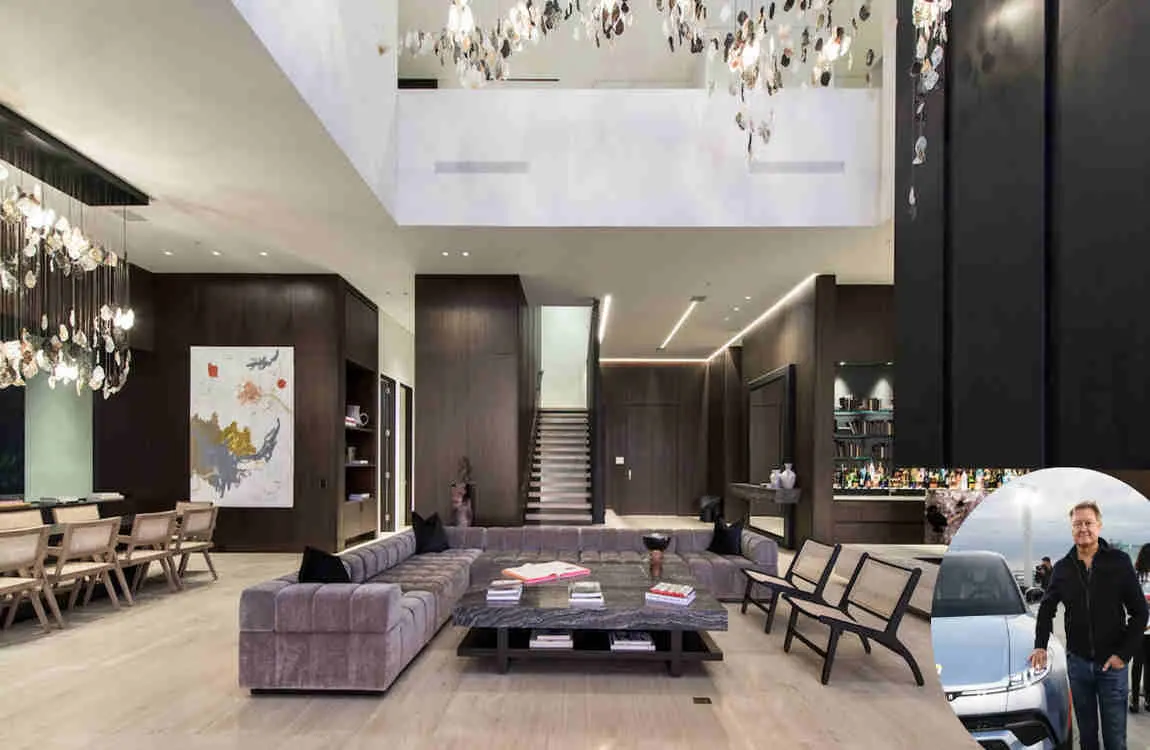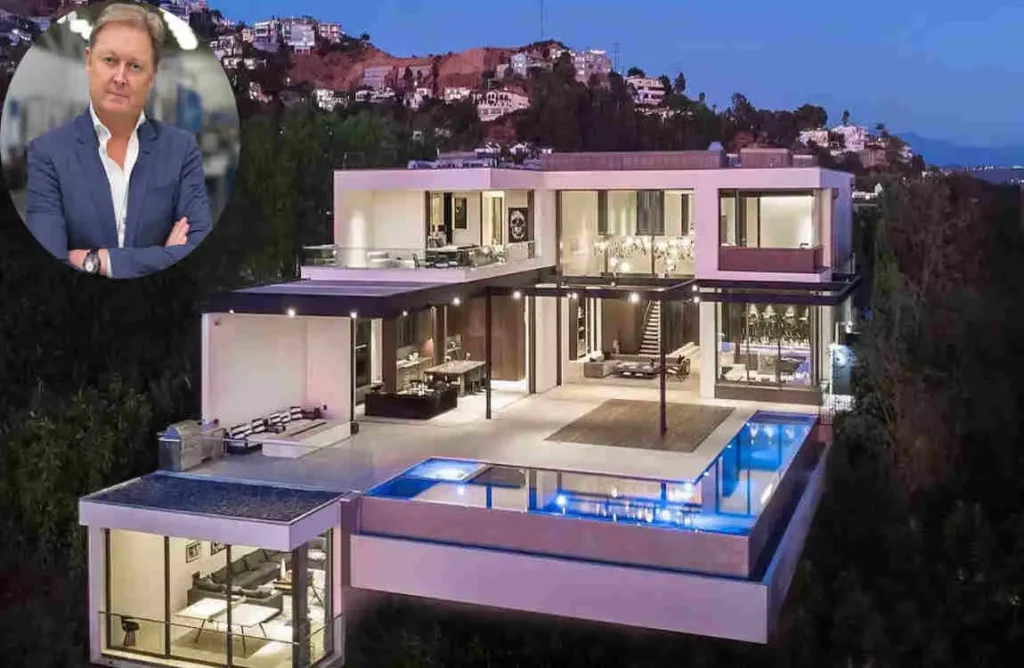Imagine walking into a home that feels like it’s straight out of the future, where sleek lines from high-end cars meet the warmth of nature. That’s the magic of the Henrik Fisker house, a stunning example of how one man’s vision can redefine what a luxury home looks like. If you’re someone who loves architecture or just dreams of a beautiful living space, this place will captivate you.
Henrik Fisker isn’t just any designer; he’s a trailblazer who jumped from crafting luxury cars to building dream homes. Born in Denmark, Fisker made his name designing iconic vehicles like the BMW Z8 and the Aston Martin DB9. But his passion didn’t stop there. In recent years, he turned his eye to architecture, blending his love for speed and style into living spaces.
| Information | Details |
|---|---|
| Full Name | Henrik Fisker |
| Date of Birth | August 10, 1963 |
| Nationality | Danish-American |
| Occupation | Automotive Designer, Entrepreneur |
| Spouse | Geeta Gupta-Fisker |
| Children | 1 |
| Education | Art Center College of Design |
| Notable Works | BMW Z8, Aston Martin DB9, Fisker Karma |
| Estimated Net Worth | Approximately $500 million to $550 million (2024) |
| Primary Sources of Wealth | Automotive Design, Entrepreneurship, Investments |
| Current Residence | Los Angeles, California, Hollywood Hills (home listed for sale for $35 million in 2024) |
What makes the Henrik Fisker house so special? It’s a perfect mix of cutting-edge design and everyday comfort. Fisker believes homes should be more than just shelters – they should inspire and sustain. This house embodies that idea, using innovative materials and smart layouts to create a space that’s both luxurious and livable.
Who is Henrik Fisker? – Background and Design Philosophy

Henrik Fisker has always been a creator at heart. Starting his career in the auto industry, he worked for big names like BMW and Aston Martin. He even founded his own company, Fisker Automotive, which focused on electric cars. But around 2010, Fisker began exploring architecture, seeing it as an extension of his design skills. Today, he’s known for pushing boundaries in both fields.
Fisker’s shift from cars to homes wasn’t random. He saw similarities between designing a vehicle and a house – both need to be functional, beautiful, and efficient. In the Henrik Fisker house, you can spot echoes of his car work, like streamlined shapes that make spaces feel dynamic.
At the core of Fisker’s approach is minimalism. He strips away the unnecessary, focusing on clean lines and open areas. This isn’t about being plain; it’s about creating calm and focus. Imagine a room where every element has a purpose – that’s Fisker’s style.
Sustainability plays a huge role, too. Fisker designs with the planet in mind, using eco-friendly materials and energy-saving tech. In the Henrik Fisker house, this means things like recycled wood and solar power, making luxury feel responsible.
Luxury is another key pillar. Fisker believes high-end living shouldn’t sacrifice comfort. His homes feature premium touches, like custom lighting and plush fabrics, all while keeping things innovative.
Innovation ties it all together. Fisker loves experimenting with new ideas, from smart home systems to unusual building methods. This philosophy shines in the Henrik Fisker house, where automotive influences create unique features.
How does this relate to you? If you’ve ever dreamed of a home that’s stylish yet sustainable, Fisker’s ideas could inspire your next project. His work shows that great design comes from blending passions.
Fisker’s background in Henrik Fisker design has shaped modern architectural trends. By bringing car-like precision to homes, he’s influencing how we think about living spaces.
In essence, Fisker’s philosophy is about harmony between form, function, and the environment. The Henrik Fisker house is a living example of this balance.
Overview of the Henrik Fisker House
| Aspect | Details |
|---|---|
| Specifications | Approximately 12,000 sq. ft. on 3 floors |
| Architectural Design | Contemporary luxury design with emphasis on spaciousness |
| Features | Includes luxury amenities such as a gym |
| Worth | Purchased for around $21.75 million in 2021; listed for sale at about $35 million |
| Address | Located in Hollywood Hills, Los Angeles |
| History | Purchased in 2021, Henrik Fisker attempted to sell the mansion shortly after acquisition |
Nestled in the hills of California, the Henrik Fisker house sits on a sprawling five-acre lot. This location offers stunning views of the ocean and mountains, making it a peaceful retreat from city life. Fisker chose this spot to blend his home seamlessly with nature.
You may also read (kid rock white house).
The house itself spans about 8,000 square feet, with a layout that’s open and inviting. It includes multiple levels, connected by elegant staircases and glass elevators. The purpose? To create a space for family, work, and relaxation all in one.
What sets the Henrik Fisker house apart is its unique style. It’s a fusion of modern minimalism and organic elements, with curves inspired by Fisker’s car designs. Unlike boxy traditional homes, this one flows like a sculpture.
Fisker’s personality shines through every detail. As a designer, he infused the space with personal touches, like custom art pieces and hidden tech features. It reflects his vision of a home that’s innovative yet warm.
For a better sense, imagine looking at floor plans that show wide-open living areas merging with outdoor patios. Photos reveal glossy facades and lush gardens. If you’re visual, search for designer sketches online – they capture Fisker’s creative process.
The scale feels grand but not overwhelming. Rooms are designed for real life, with spaces for entertaining or quiet evenings. This balance makes the Henrik Fisker house a model for luxury living.
Location-wise, its California setting influences the design. Think earthquake-resistant structures and drought-tolerant plants. It’s built to last in a dynamic environment.
Overall, the aesthetics scream sophistication. The facade uses glass and steel for a sleek look, while inside, natural wood adds warmth. It’s different from cookie-cutter homes because every choice tells a story.
Fisker’s automotive flair appears in aerodynamic shapes that guide airflow and light. This isn’t just pretty; it’s practical, reducing energy needs.
If you love exploring unique homes, the Henrik Fisker house offers endless inspiration. Picture yourself there – what room would you head to first?
Architectural Features that Define the Henrik Fisker House

The Henrik Fisker house stands out thanks to its clever structural innovations. Fisker used advanced building techniques, like modular construction, to assemble the home quickly and efficiently. This method reduces waste and allows for flexible layouts.
One key feature is the framework. It incorporates lightweight steel beams that mimic the chassis of a car. This provides strength without bulk, letting the house feel airy and open.
Let’s talk materials. Fisker chose sustainable options like reclaimed timber and recycled metals. These aren’t just eco-friendly; they add a luxurious texture. For instance, the floors use bamboo, which is durable and grows fast.
High-tech elements include smart glass that changes tint for privacy or light control. It’s like having windows that adapt to your needs.
Inside, the design highlights open-plan spaces. Walls are minimal, creating a flow from the kitchen to the living area. Natural light floods in through massive windows, making rooms feel bigger and brighter.
Smart home tech integrates seamlessly. Voice-activated systems control lights, temperature, and security. It’s all about convenience without clutter.
On the exterior, landscaping blends with the architecture. Native plants surround the house, requiring little water. The facade features curved panels that echo Fisker’s car designs, adding a dynamic look.
Glass plays a significant role, with floor-to-ceiling panels offering panoramic views. Natural elements like stone accents ground the modern vibe.
Signature features include custom furniture designed by Fisker himself. Think ergonomic chairs with automotive-inspired curves. There’s even a bespoke installation – a wall of kinetic art that moves with the wind.
Fisker’s car background inspires functional touches, like aerodynamic rooflines that improve ventilation. Curves aren’t just for show; they guide airflow naturally.
In the kitchen, high-end appliances hide behind sleek panels, maintaining that minimalist aesthetic.
Bedrooms offer tranquility with soundproofing and mood lighting. It’s luxury that feels personal.
How does this inspire you? If you’re remodeling, consider borrowing these ideas for your space.
Structural Innovations in Detail
Under the hood – or rather, under the roof – the Henrik Fisker house uses earthquake-resistant foundations. This ensures safety in California.
Modular sections allow for easy expansions. Fisker designed it so owners could add rooms as needed.
Material Choices and Their Benefits
Here’s a quick list of key materials:
- Reclaimed Wood: Adds warmth and reduces deforestation.
- Recycled Steel: Strong, lightweight, and eco-conscious.
- Smart Glass: Energy-efficient and versatile.
- Bamboo Flooring: Sustainable and resilient.
These choices make the house both beautiful and practical.
Interior Highlights
Open spaces encourage family time. Imagine cooking while chatting with guests across the room.
Natural light boosts mood and reduces electricity usage. Fisker positioned windows to catch the sun’s path perfectly.
Exterior Elements
The facade’s curves create visual interest. Landscaping includes drought-resistant gardens, tying into sustainability.
Glass elements blur indoor-outdoor boundaries, making the house feel part of the landscape.
Automotive Inspirations
Curves from car designs improve aerodynamics, which helps cool the home naturally. It’s a clever nod to Fisker’s roots.
Functional beauty means every feature serves a purpose, like hidden storage that keeps things tidy.
To visualize better, let’s look at a table comparing traditional homes to the Henrik Fisker house:
FeatureTraditional HomeHenrik Fisker House
Layout : Boxy, closed rooms , Open-plan with fluid spaces
Materials : Standard wood and brick , Sustainable like bamboo and recycled steel
Lighting Artificial heavy reliance Maximized natural light with smart glass
Sustainability is often overlooked. Integrated solar and eco-materials
Tech Integration Basic appliances Full smart home with voice controls
This table shows how Fisker’s design elevates everyday living.
Signature touches, like a custom garage that doubles as an art space, reflect his personality.
Overall, these features make the Henrik Fisker house design a benchmark for innovative architecture.
Sustainability and Technology Integration in the Henrik Fisker House
Sustainability isn’t an afterthought in the Henrik Fisker house; it’s baked into every decision. Fisker incorporated green building practices from the start, like using low-impact construction methods that minimize site disturbance.
Energy efficiency comes from solar panels on the roof. These generate enough power to run the home off-grid on sunny days. It’s a simple way to cut bills and carbon footprints.
HVAC systems are top-notch, with geothermal heating that uses the earth’s stable temperature. This keeps the house comfortable without guzzling energy.
Bright lighting adjusts based on time and occupancy, saving electricity. You can control it all from your phone – convenient.
Water conservation is key, too. Rainwater harvesting systems collect and filter water for irrigation. Low-flow fixtures in bathrooms reduce waste without sacrificing luxury.
Eco-friendly landscaping uses native plants that thrive without much water. This creates a beautiful yard that’s kind to the environment.
Fisker’s philosophy aligns perfectly here. He sees sustainability as part of luxury, not a compromise. In the Henrik Fisker house, sustainability, you get both elegance and responsibility.
Benefits include lower utility costs and a healthier planet. Imagine living in a home that gives back – that’s the appeal.
Tech integration enhances this. Smart sensors monitor energy use, suggesting improvements. It’s like having a personal eco-coach.
Consider adding similar features to your home. Start small with solar lights or smart thermostats.
Keywords like eco-friendly architecture and smart home technology define this space.
In short, the Henrik Fisker house proves sustainable living can be stylish and high-tech.
The Influence of Henrik Fisker House on Modern Architecture and Design Trends
The Henrik Fisker house has made waves in the architectural world. Designers and enthusiasts rave about its blend of luxury and eco-friendliness, setting a new bar.
It influences trends by showing how to mix minimalism with sustainability. Other architects now incorporate similar curves and green tech in their projects.
For example, firms like those inspired by Fisker are creating homes with automotive-style aerodynamics for better energy flow.
This house impacts luxury residential developments. New builds in places like Los Angeles echo its open layouts and natural integrations.
Broader trends include a shift toward modern sustainable homes. People want homes that look great and tread lightly on the earth.
Fisker’s work inspires homeowners, too. You might see more solar integrations or recycled materials in everyday renovations.
The Henrik Fisker house inspiration extends to design shows and magazines, where it’s featured as a trendsetter.
In the community, it’s sparked discussions on blending industries – like auto and architecture.
Future trends? Expect more hybrid designs that prioritize innovation and responsibility.
How has this influenced you? It may be time to rethink your space with Fisker’s ideas in mind.
Visiting or Experiencing the Henrik Fisker House
The Henrik Fisker house is primarily private, owned by Fisker himself. It’s not open for public tours, respecting his privacy.
However, you can experience it virtually. Online platforms offer 360-degree tours and high-res videos. Search for “Henrik Fisker house tour” to dive in.
It’s sometimes featured in design shows or architecture expos. Keep an eye on events in California.
For architecture lovers, tips include studying photos and sketches online. Apply lessons like open spaces to your home.
If inspired, visit similar modern homes in museums or public exhibits.
Engage with architectural tourism by exploring Fisker’s other works or related designs.
Where Does Henrik Fisker’s Currently Live?
Henrik Fisker currently lives in Los Angeles, California. More specifically, he has been living in a large, luxurious mansion in the Hollywood Hills area. However, as of 2024, he is selling this mansion, which is a modern, 11,800 square-foot home with six bedrooms and eight bathrooms, featuring an infinity pool, retractable glass walls, and a garage that can hold up to six vehicles. The home offers panoramic views from Downtown Los Angeles to the Pacific Ocean. The asking price for the house is $35 million. It is not clear yet where Henrik Fisker plans to move after selling this residence.
You may also read (brian shaws house).
